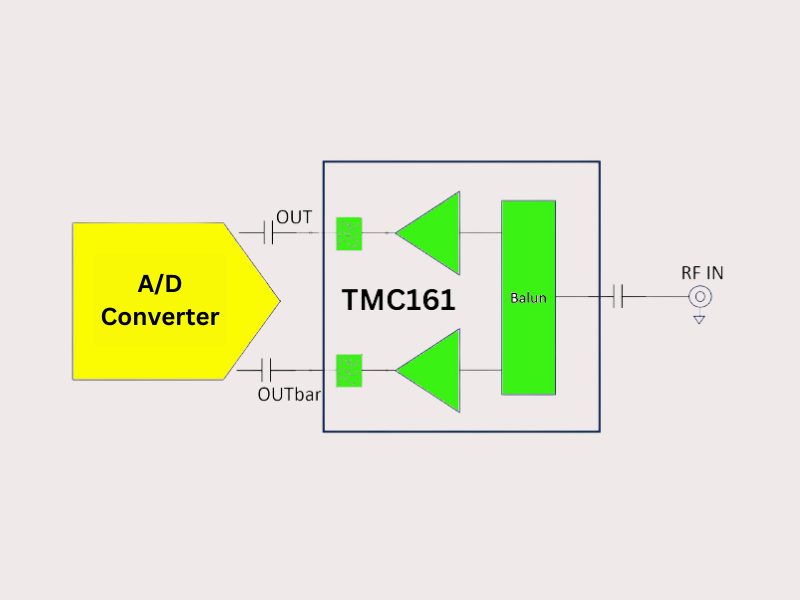
—Family of RF interface devices for driving high-speed A/D converters to Ka-Band
—Low noise and high OIP2/OIP3 maximize the dynamic range and sensitivity of software-defined radios
—TMC161 integrates an input balun with bias T; quasi-differential low noise, high OIP2/OIP3 amplifiers; and dual lowpass filters in a 7 mm x 7 mm QFN
mmTron announces the release of a family of MMICs for driving high-speed analog-to-digital (A/D) converters. The TMC161 family converts a single-ended RF input to a differential output to drive A/D converters for direct-sampling applications from L/S/C- into Ku- and Ka-Band. The TMC161 provides low noise, high linearity (low IMD2 and IMD3 distortion) amplification and anti-alias filtering.
MARKET NEED
Increasing data converter Nyquist sampling rates and instantaneous bandwidth have enabled a simplified RF front-end architecture to be adopted by many applications. System benefits include simpler frequency planning; high spur-free dynamic range (SFDR); reduced latency; low analog phase and amplitude uncertainty; simplified channel synchronization; and lower size, weight, power, and cost (SWAP-C).
“Higher A/D converter sampling rates are enabling direct digital conversion at ever-increasing bandwidths, making the quality of the RF signal presented to the A/D converter critical to maximizing the system's dynamic range and sensitivity,” said Seyed Tabatabaei, mmTron’s CEO and founder. “Our skilled team designed the TMC161 family to provide high SFDR and low noise amplification with low IMD2 and IMD3 distortion, while converting a single-ended RF input to the differential signal required by high sample-rate A/D converters. The integration provides SWAP-C advantages for software-defined radios.”
APPLICATIONS
EW systems must simultaneously track multiple targets and instantaneously tune across a wide frequency range to implement complex sweeping and hopping patterns. The TMC161 and its companion TMC160 digital-to-analog (D/A) converter interface extend the frequency range of direct digital processing in these systems into Ka-Band.
In addition to EW, the TMC161 simplifies the design of software-defined radios for instrumentation, radar, satellite communications, and 5G, enabling the receiver to process a much wider instantaneous bandwidth in less time than previous solutions.
PERFORMANCE
The TMC161 integrates an input balun with bias T, quasi-differential low noise amplifiers, and anti-alias lowpass filters in a 7 mm x 7 mm air-cavity surface-mount QFN. The anti-alias filters can be custom designed to reject specific clock and mixing frequencies.

Each product in the family provides 10–16 dB gain with 6 dB noise figure and 29–33 dBm output third-order intercept (OIP3). Biased with 5 V and –0.7 V, the RFIC draws 250 mA. The internal bias T eliminates the need for an external inductor, simplifying amplifier biasing.
AVAILABILITY
Characterization data, samples, and reference design assistance are available for customer evaluation for the TMC160-16, which covers 3–16 GHz. 12 and 18 GHz versions will be available during the fourth quarter of 2023.
To receive more information, including datasheets, email mmTron at contact@mmtron.com.
